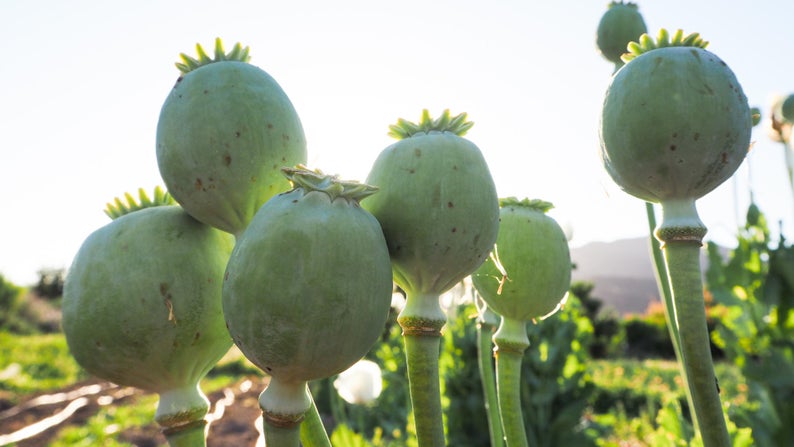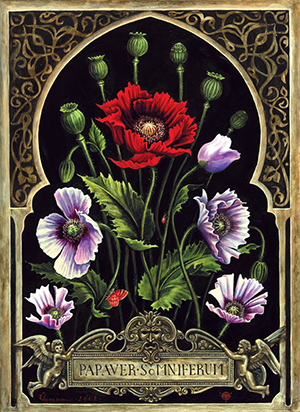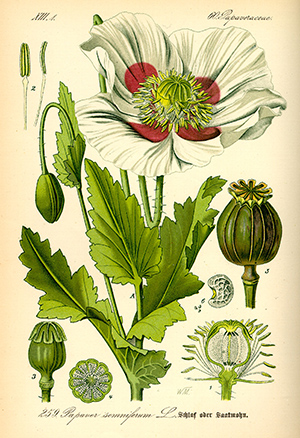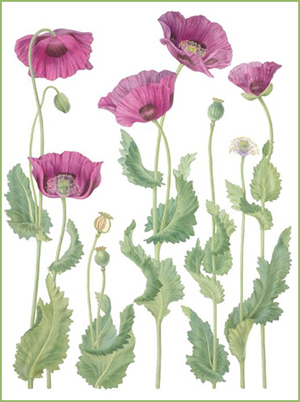Papaver Somniferum L. - Opium Poppy
This widely cultivated plant is familiar in many garden where, once sown, it often comes up without fail year after year, never failing to surprise and delight in its subtle variations of flower shape and color. Opium resin contains a complex mixture of alkaloids (over 20 have been isolated) that include codeine, morphine, narceine, narcotine, papaverine and thebaine, all of which are of significant use in the pharmaceutical industry. These are extracted from the latex present primarily in the fruit-capsule and in the upper stem. Many different varieties of opium poppy are grown for medicine and differ primarily in the ratio and quantities of different alkaloids. Medicinal drugs based on opium are analgesic, sedative and antispasmodic, as well as soporific, and are also used in the treatment of various stomach disorders.
Crude opium is gathered for the narcotic trade by lancing the semi-mature capsule with a series of longitudinal grooves using a special implement for the purpose, Latex, which is contained in specialized (articulate lactiferous vessels) close to the surface, exudes along these grooves to accumulate at the base of the capsule. Within 24 hours it solidifies and can then be collected. This brown gum is rolled into balls and stored – it will keep for a long time – and is converted to heroin by a process of ‘cooking’ and the addition of various chemical catalysts.
Despite its sinister attributes, the opium poppy is a delightful garden plant, existing in a range of different and exciting forms. The diverse varieties of the poppy have colors that are commonly either white, red, dark purple, scarlet, or a mixture of some of these. P. somniferum is an erect, generally unbranched, hairless, leafy annual, up to 1 meter (3 ft) tall, sometimes more. The bluish or greyish leaves are rather fleshy, oblong in outline but pinnately lobed and rather undulate along the margin, the lower short stalked, but the upper unstalked and clasping the stem with broad bases. The large cup shaped, erect flowers are 2-5 inches (5-12 cm) across in wild forms and up to 7 inches (18cm) in cultivated forms, generally white to pink or purple, often with a dark blotch at the base of each petal; the flowers are borne on long stalks, dripping at the tip in bud. There are many cultivars in the Papaver Somniferum family, see below for some of the more popular that are cultivated today.

Papaver Somniferum Cultivars
The true opium poppy is known as Papaver Somniferum L. and is a member of the poppy family papaveraceae. This family contains over 100 species with many varieties. Many are well adapted to alpine regions, where water is plentiful in the spring and the later summer is dry.
Of the many species of poppy, only a handful contain the opium alkaloids, Papaver Somniferum is the main species used for this. However, there are many cultural varieties of P. Somniferum, varying in the color of the flowers and seeds, time until harvest, size of the capsules, etc. This species is used for the production of poppy seeds and seed oil for baking.
P. Somniferum is an annual herbaceous plant, i.e., completing its life cycle in one growing season. The main root is fusiform with some lateral branching into the surface soil. As with other poppies, the plant goes through an initial leafy rosette stage, followed by a bolting to form the flower stalk. The leaves are large, and may be entire, but more often slightly serrated. The color is green with a blue-grey cast. The plant normally bolts in the spring and produces 3-7 flower stalks. The bloom and stem appear waxy with grey-green cast. The flower buds are small or all shaped with 2 large sepals encapsulating the forming flower. These fall off when the flower emerges. The typical opium poppies are the white, violet, pink, or red varieties. Most varieties are single with 4 petals, though some sculptured and double varieties are cultivated. The central single pistil is surrounded by a ring of 150-200 stamens, in 5 concentric circles. The stigma is star shaped with 5-16 rays. Fertilization is usually direct from the surrounding stamens and from 800-2000 seeds are produced. The seeds are usually grey or blue or black.





